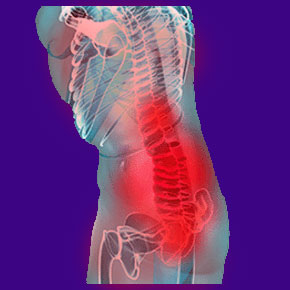
Back pain with fever is a common combination of symptoms that is usually relatively harmless and is likely to be indicative of a viral or bacterial infectious process. In other cases, the back pain and fever might be related to activity, such as overwork combined with sunburn, more than any systemic infection. However, there are times when fever in the presence of back pain is a symptom of a far more serious condition.
Fever is a warning sign that something is amiss in the body. Most fevers do not rise very high and are extremely useful at ridding the body of contaminants. Other fevers are generated in response to bodily stresses, such as radiation, disease or pharmaceutical product ingestion. Fevers that are accompanied by back pain, or any type of pain, should be investigated if a definitive cause is not known or suspected.
This discussion provides a comprehensive view of fever that accompanies dorsal pain in the neck, middle spine or lower lumbar regions. We will examine the most typical expressions of back pain and fever, as well as provide an overview of some less common origins of both symptoms.
Typical Causes of Back Pain with Fever
Back pain is a known symptom of many different types of common infectious conditions. All of the following circumstances can cause back pain to accompany fever and possibly other types of symptoms:
The flu is one of the most widely seen back pain and fever combinations. Influenza is known to create a rise in anatomical temperature in many patients and this fever might become quite high. Widespread back muscle soreness is commonly reported with the flu, as is acute pain near the kidneys or surrounding some of the glandular and lymphatic structures in the body. High fever itself can cause muscular pain, as well as skin sensitivity and general discomfort throughout the body. Since many patients lie in bed when they are sick with the flu, it is common for the continual pressure exerted on the dorsal anatomy to exacerbate soreness experienced therein.
Some colds and allergy syndromes might involve low level fevers and back pain might be a result of constant deep coughing in response to irritants or mucus accumulation.
All types of infections have the potential to cause fever as the body seeks to be rid of the germs. Skin infections, specific organ infections and general systemic infections can all generate fever. Once again, the fever is often the cause of general bodily pain and soreness. Some serious infections strike the spine itself, such as meningitis or discitis. Luckily, these types of infections usually demonstrate unique symptoms that warn caregivers of their presence and help the patient to enjoy quick emergency medical intervention upon evaluation.
Atypical Causes of Fever and Back Pain
There are less often seen scenarios where back pain might be present along with fever. Some of these circumstances include any of the following conditions:
Many people perform exhausting outdoor work that can cause back muscle soreness, as well as being exposed to radiation from the sun that might cause sunburn. Serious sunburns can cause low to medium grade fevers for a short time, generally within hours after exposure.
Some drugs can cause muscular pain, stiffness and soreness, as well as slightly elevated temperatures. Patients who experience such symptoms when starting new medications should report these effects to their doctor immediately, unless they have already been warned of these expressions being likely to occur.
Cancer is a common cause of idiopathic fever, especially of a chronic or recurrent variety.
Some vaccines can cause mild to moderate fever, as they introduce contaminants into the body to illicit an immune response. Remember that fever is a basic immune response to infection, even if it is purposefully inflicted.
Blood clots and deep vein thombosis can create acute fever and the existence of back pain might be related to the fever itself or the location of a clot.
Autoimmune conditions are well known to cause back pain with fever recurrently or chronically. Since many autoimmune conditions are related to the mindbody interactions, fever might be another symptom of a psychogenic pain process in some patients. Some of the most common automimmune conditions that might create fever include gout, IBS, rheumatoid arthritis, fibromyalgia, lupus, Crohn’s disease, ankylosing spondylitis and psoriasis.
Overactive thyroid is a relatively common cause of fever and regional pain in the neck of older people. Thyroid problems can defy diagnosis for a long time without proper bloodwork.
Back Pain with Fever Guidance
Fever leaves the body feeling sore, stiff and uncomfortably warm. Many people also experience severe chills and subsequent shaking that are known instigators of muscular spasms. For people with a known history of back problems and spasm, this can be terrifying and torturous.
Most fever is useful, productive and harmless in the grand scheme of good health. Fevers help our bodies to remain free of dangerous infections, but sometimes are unproductive and caused by sources that should be identified and remedied, when possible.
If you experience unknown high fever and severe back pain, it is always safe to contact your doctor or local hospital for evaluation. In most cases, the condition will turn out to be a complete nonissue, but for a few patients, early intervention will help them to receive the help they need for serious conditions such as spinal meningitis or discal infection.





